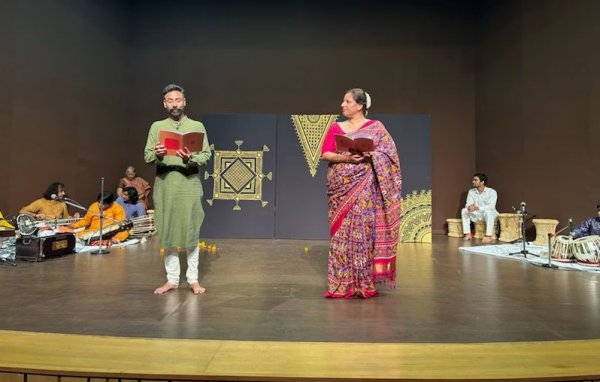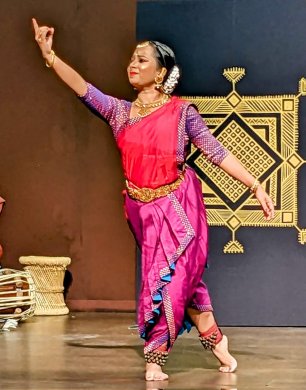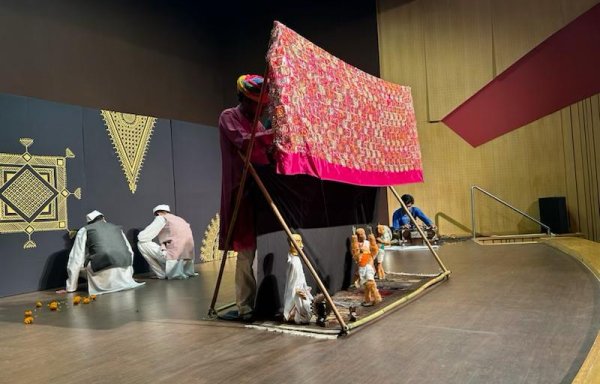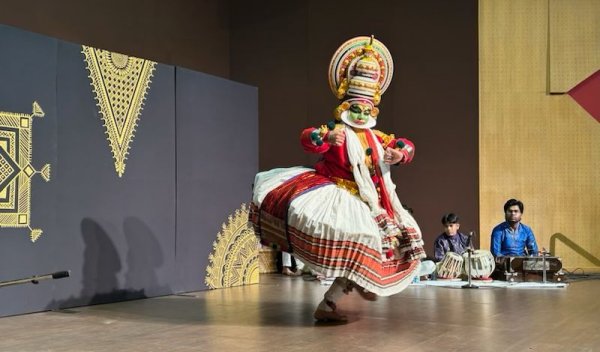
|   |

|   |
 e-mail: leelakaverivenkat@gmail.com Celebrating Gandhi Jayanti through Gandhi Leela Photos courtesy: Suranya Aiyar October 10, 2022 How refreshing and fitting to mark Gandhi Jayanti with a performance of Gandhi Leela, chiming with the Ram Leela festivities, celebrating the victory of good over evil! Conceived and directed by script writer Suranya Aiyar, a unique feature of the presentation by Bhagyam Arts and Ideas at Jawahar Bhavan, New Delhi, lay in the all-inclusive nature of the theme uniting people of all ages, young and old, while providing participating opportunities for every genre of talent, from the purely recitative, to different forms of music and dance, to puppetry to pantomime and what have you. And above all, coincidentally or by design, here was a broad blueprint, which through accommodating all types of performances can usher in variety, while remaining anchored to the theme of spreading the message of the Mahatma to all levels of society.  Rajesh Kumar and Suranya Aiyar on Satyagraha The curtain goes up on a dialogue between Sutradhars Rajesh Kumar (representing the Mahatma) and Suranya Aiyar (as the colonial master), with the former trying, not very successfully, to educate the Englishman on principles of Satyagraha (holding on to truth), the policy of non-violent resistance to evil - the bedrock of Gandhiji's philosophy, first tried out in 1917 in Champaran of South Africa, to later become the major tool of protest in India's fight against British imperialism. Fashioned on a rigorous process of self- scrutiny alongside a totally nonviolent mind, Satyagraha's stoic civility succeeded in defeating the violent repression by the imperialists. The master's much loved prayer song "Vaishnava Janato" playing softly turns into a dirge as it is abruptly interrupted by the firing of shots, indicating the horror of the Mahatma having been murdered while going for his prayer. Thoughts expressed through Swarnali Kundu's commendable Bharatanatyam efforts, were followed by Akash Mallik's Kathakali interpretation. While the general getup with skirt and headgear along with neat mudras were expressive enough, one felt that the absence of elaborate 'pacha' makeup, not to speak of the strong mukhabhinaya so much a part of the dance form made the projection somewhat minimal, though one understands this was necessitated by the actor having to appear again in another scene (and the makeup is not easily removed). Playing in the hinterland was Rajesh Kumar's voice voicing Pandit Nehru's broken voice, full of grief, broadcasting to the country. "The light has gone out of our lives." Sensitive music rendition was a major part of the entire production, with Ustad Arif Ali Khan's music direction aided by his deputies Arshul Ameen and Gourav Sharma.  Swarnali Kundu One of the most evocative scenes for this critic was the one with Purwa Bharadwaj reading out parts of Mahadevi Varma's Hindi work Punya Smaran on Bapuji, even as, in simultaneity, in the background, stood artist Estiak Ali working on his easel, his drawing of bold lines, capturing in a trice, a remarkable likeness of the Mahatma in a portrait. Mahadevi Varma's words make one of the most insightful statements on Gandhi the man, who despite an unprepossessing physical appearance, attracted and held the world's gaze, through the sheer power of his mind with its brilliant ideational originality. A large heart which could forgive any wrong, eyes which reflected an inner radiance and luminosity and large ears which never failed to hear the softest decibel of joy or suffering, comprised this man who was the only one of his kind the world has experienced. The music with main singer Monika Tarachand along with Amrina Arif and Rumana Arif added its strong feel of atmosphere to the proceedings.  Mela scene with Puppets To music like Bharat Tiwari's lyric "Bapu Gandhi", rendered by Gourav Sharma and Arshul Ameen as lead vocalists, unfolded the scene of sheer fun and joy of the Mela, which true to its nature was a Harlequin mix of presentations - lively Bharatanatyam by the tiny tots of Nadasutra, magic show by Junaid Rehman, Kathputli by the puppets of Santosh Bhatt and his troupe, and last but not the least, mime actors of Jagran with the pantomime artistes flashing a collage of the three faces of monkeys, with hand covering eyes, ears and mouth respectively- underlining the "see no evil, hear no evil and speak no evil" motto - as part of what Gandhi believed in. Punning on Gandhiji's name Mohandas Karamchand Gandhi, the song "Baji Mohan ki pyari been" was again interpreted through the two classical dances Kathakali and Bharatanatyam. While Akash Mallick donned a pacha role to show Krishna the charmer with the flute, the same idea in Bharatanatyam saw Swarnali Kundu with her team of Urmi Gupta, Parineet Kaur and Antarleena Bera, in a group rendition. L Manak Malhotra's leading vocal support with Manohar Balachandirane's peppy mridangam, provided the vibrant musical backdrop.  Akash Mallik To bring down the curtain with a musical finale Rang Bharat was an excellent idea, for Gandhi and his life are a symphony for many. The Mahatma, who believed in striking a balance between spirituality and Art through music, admitted that but for the music and laughter in his mind, senses and heart, he "would have died of this crushing burden of my work". For him, music, which was much more than what one produced through voice and throat, was a great healer and harmonizer with the ability to forge together people of different regions and ideas. Music acted as one of the principle tools for fostering the Sarvadharma Sambhav the Mahatma sought. In his Sabarmati Ashram, the music teacher Narayan Moreswa Khare (whose Ashram Bhajanavali is regarded as a veritable musical Bible for spiritual music) helped organize the Bhajan Sandhya which became famous. The songs were set in simple tunes drawn from main 'Thaats' of Hindustani classical like Khamaj, Bhairavi, Desh and Kaafi. Very sensitively crafted, the finale, in tracing a history of music in India from the days of the Rig Vedic recitations, to a progression through the corridor of time, underlined the all-inclusive nature of Indians as a people open to ideas from different cultures - a feature Gandhi was very aware of. India's varied musical genres include types of classical, folk, regional, film music, patriotic songs, pop, spiritual music, rock and what have you. It was wonderful to hear the smooth gliding from one genre of music to another using one liners which were clear indicators of the person and type of music represented. While music for Gandhiji was a great unifying force, he related to poetic and musical contributions even of people with whom he shared a strange and complex relationship, of disagreement along great mutual respect - like with Tagore whose songs like "Ekla Chalo" were dear to his heart - even while Tagore and Gandhi had vast differences in their approach to many of India's problems. For Tagore, Gandhiji's Civil Disobedience Movement which encouraged acts like burning of foreign made garments, amounted to an incitement of passions in the mob which could become difficult to control. But with all the open differences, each had great respect for the other, and if Gandhi was the undisputed 'Mahatma' for Tagore, the latter was always 'Gurudev' for Gandhiji. It was interesting to see how cleverly the scene was composed, creating whiffs of nostalgia for what was. Film music had its expression in "Babul mora..." evoking memories of Ashok Kumar's voice. Even as Kabir's poetry which believed in no religion and addressed Hindus and Muslims alike was dear to Gandhiji who wanted Hindu/Muslim unity above all, his belief in the varnashram system with a fair deal to scheduled castes and tribes, was different from Kabir's non-religious approach. While Kabir was a spiritual reformer, Gandhiji was a social reformer. In the midst of Hindustani ragas, it was interesting to suddenly come across Vyasaraya's Carnatic masterpiece "Krishna nee begane baro" in Yamuna Kalyani. This fusion of so many elements, without jerks in the narrative, was a delight and kudos to music director Ustad Arif Ali Khan, and the long line of well coordinated singers and instrumentalists including percussionists. Altogether a commendable effort uniting an array of talents, in a varied tribute to the Mahatma!  Writing on the dance scene for the last forty years, Leela Venkataraman's incisive comments on performances of all dance forms, participation in dance discussions both in India and abroad, and as a regular contributor to Hindu Friday Review, journals like Sruti and Nartanam, makes her voice respected for its balanced critiquing. She is the author of several books like Indian Classical dance: Tradition in Transition, Classical Dance in India and Indian Classical dance: The Renaissance and Beyond. Post your comments Pl provide your name and email id along with your comment. All appropriate comments posted with name and email id in the blog will also be featured in the site. |